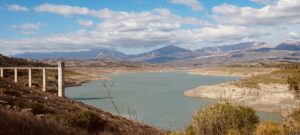Still trying to decide what to do about Steve’s bike, it was disappointing to find the campsite we’d chosen as a quiet refuge for a couple of days didn’t really fit the bill. Leaving at 1130 on Saturday, 11 February Bev had found what turned out to be an excellent campsite in La Herradura, a drive of just over 100 miles.
We decided to avoid Málaga and managed to find the scenic route up over the Puerto del Leon (960m) in the Montes de Málaga to Colmenar, then drove back down towards the coast past the Viñuela Reservoir. Built across the River Guaro, it can hold 170 cubic hectometres, the highest-capacity reservoir in the province of Málaga. However, it’s currently less than 10% capacity and, since last year there have been so-called ‘water wars’ in local communities. Many farmers have switched to growing more lucrative sub-tropical crops such as mangoes and avocados, rather than oranges, lemons and olives. These require irrigation and use more water for a successful harvest. Whilst some blame the water shortages on this switch in farming practice, others claim it is climate change. Whatever the reason, drought is certainly a real issue for everyone in this part of Spain.
We joined the coast road at Torre del Mar, a huge seaside resort stretching for several miles and sprawling back from the beaches with closely packed holiday hotels and high rise apartments. We wonder if we’ve made a mistake coming to this stretch of coastline! However, as the road winds towards Nerja, there’s less holiday developments and the coastline is certainly stunning with waves crashing against the cliffs protecting each large bay. We catch glimpses of the huge viaducts carrying the Autovía del Mediterráneo A7 from Málaga to Almeria. Our destination is La Herrudara, meaning ‘horseshoe’ due to the shape of the bay. It’s too small to warrant a mention on our road map, tucked between Nerja and Almuñécar. En route, we stop to admire the Acueducto del Águila, built in 1880 to carry water from Nerja town to the sugar refinery in Maro, Las Mercedes for irrigation. The factory is now closed but the aqueduct continues to be used for local irrigation.
At first glance, the campsite does look like a carpark, but as we drive in the charming owner greets us with the offer of a pitch at the far end, under some avocado trees. It’s only €18 a night with excellent services, large pitches, good security and a very friendly atmosphere for just 40 vans. There’s plenty of local shops nearby so we stock up, take a quick stroll on the beach (less than 100 metres from the campsite) and cook supper in the van.







